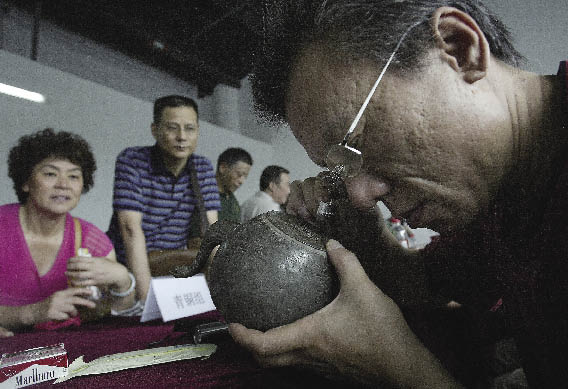| Having Your Art and Eating It Too
By staff reporter ZHOU CHANG
 |
|
The Chinese version of the Antique Road Show has an interesting twist: they break the fakes. |
IN May 1900, a Briton spent 10 pounds for an old Chinese vase. On July 15, 2005, his offspring sold the vase for £3.5 million. Over a century plagued by two world wars and miscellaneous other crises, the value of this collectable accrued at an average rate of 1,000 percent per day. Prominent and reputable Chinese art collector and connoisseur Ma Weidu tells this story to illustrate why art collecting, encouraged by such extreme profits, has become vogue in China.
Fever Rising
According to a report issued last November by the Art Market Analysis and Research Center of the Central Academy of Fine Arts, the gradual recovery from the global financial crisis was accompanied by signs the Chinese art market was picking up in the third quarter of 2009. During the autumn auction season, Chinese auctioneers took bids on four items that finally went for sums in excess of RMB 100 million; the highest, at RMB 151 million, was Eighteen Arhats by Ming Dynasty (1368-1644) painter Wu Bin.
The inherent aesthetic pleasure and promise of profits make the collection of art a temptation to millions of ordinary people; art hounds are joining the ranks of art connoisseurs at a remarkable rate. According to estimates from circles of collectors, 70 million Chinese citizens are involved in this expensive hobby, and many believe the actual number is much higher than that. Old porcelain, jade ware, paintings, calligraphy pieces, coins, and furniture – almost everything that can be found in the troves of established collectors – will make fascinating collectables for the average enthusiast.
TV stations have been instrumental in stoking public fever. In recent years CCTV and many local stations have slotted participatory art collection shows into peak hours of programming. Much like the Antique Road Show, a British favorite that spawned an American and then Canadian version, the cultural relics specialists share their discriminating expertise and secrets of judgment with on-site audiences and millions of TV viewers. This avocation of high taste is close to the populace. The share of such shows has remained high, since the drama of owners bringing forward their various relics and treasures for inspection combines well with the scholarly informative learning.
Many people buy antiques and works of art as an investment. "I believe in the concept of consumptive investment, a form of investment in which consumption is primary and investment returns secondary. Art consumption has a trait that is absent in the consumption of other commodities – it is profitable," says Ma Weidu. His wisdom has inspired millions of Chinese to relax their traditional saving mentality. Even the concept of the traditional collector is being superseded by profitable consumerism designed as a hedge against inflation.
Sifting for Gold
There is great risk in the sudden mass embrace of starting and building a collection. Unfortunately it's a matter of record that between 2006 and 2009, more than 100 imperial seals from the Qianlong Reign (1736-1796) of the Qing Dynasty, or so was claimed, were sold by auction houses nationwide. But in fact, only three of Emperor Qianlong's seals were stolen out of the imperial house and found their way into unknown private hands.
Antique markets and fairs are the favored haunts of collectors. Antiques and valuables, or anything judged a collectable, can be bought at relatively low prices, but fakes are ubiquitous. It's a case of "buyer beware," so experience and the development of discrimination are cultivated into good judgment.
One need not go to big auction houses to get a start on connoisseurship. On weekends, the Baoguo Temple Square in Beijing is converted into an antique fair by itinerant venders, who line up, shoulder by shoulder and row upon row, leaving aisles of just over a meter wide for a stream of curious visitors. Six years ago, Mr. Hu bought a Qing Dynasty (1644-1911) snuffbottle here. He has good background knowledge on this kind of artifact – once an every day item – and his eyes "brightened" when they spotted it. The vender asked for RMB 500, and he bargained the price down to RMB 400.
Profit by Proxy
For collectors with untrained eyes and no time to develop them, deep pockets may be all that is necessary to cash in on art collections. Certified antiques sold by high-end markets are their choice.
There are several such malls at Panjiayuan, and Tianya Antique City is one of them. On workdays, the big storied building has only a few solitary, wandering souls; the number of visitors can be counted on your digits, even on weekends. All the shops in the building are decorated in graceful ancient style, the merchants reclining lazily in their seats, sipping from their personal teapot and keeping an eye on the few browsing hunters. These authorized professional art dealers trade in jadeite, white jade, porcelain, paintings, calligraphy and ancient furniture, and they're all pricey. For inexperienced but serious collectors, that is the cost of higher security and lower risk.
Mr. Zhou is a businessman in his 50s. He loves porcelain and has some "extra money" for this hobby of his. "I'm kind of in the dark about evaluating, but I want some worthwhile collectables and assume this is where I can get them," he confesses.
Genuine antiques are beyond the reach of the average art fan and hobby treasure hunter; high-quality replicas suit them better, both in terms of aesthetic value and price. Beijing's Hong-qiao Market specializes in duplicates of all kinds of ancient articles. A typical shopkeeper we spoke to here said that his blue-and-white porcelain duplicates sold very well. With the improvement in duplication technology, avid enjoyment of such "fakes" was inevitable, as was the ever-increasing patronage of porcelain lovers and art collectors. |
